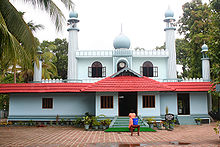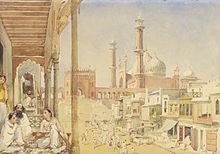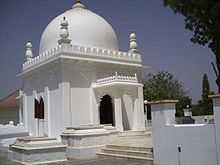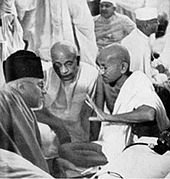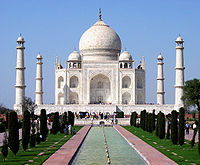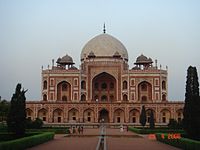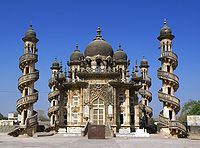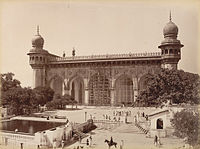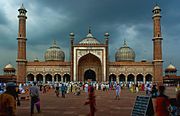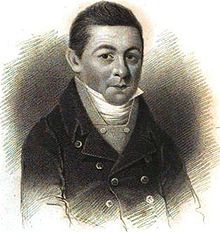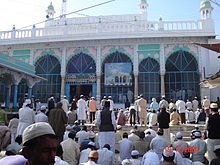- Islam in India
-
This article is about Islam in the Republic of India. For wider definitions of "India", see Islam in South Asia.
Indian Muslims 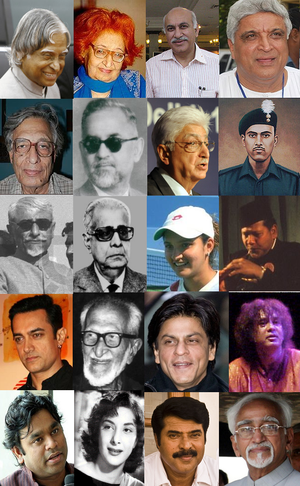
Abdul Kalam · Qurratulain Hyder · M. J. Akbar · Javed Akhtar
Irfan Habib · Zakir Hussain · Azim Premji · Abdul Hamid
Maulana Azad · M. Hidayatullah · Sania Mirza · Bismillah Khan
Aamir Khan · Salim Ali · Shahrukh Khan · Zakir Hussain
A. R. Rahman · Nargis · Mammootty · Hamid AnsariTotal population approx. 160.9 million (2009)[1] Regions with significant populations Large concentration in Jammu and Kashmir, Assam and West Bengal. Large populations in Uttar Pradesh, Bihar, Maharashtra and Kerala Languages Religion Sunni Barelvi Hanafi, Deobandi Hanafi, Ahl al-Hadith, and Shia.
Islam is the second-most practiced religion in the Republic of India after Hinduism, with more than 13.4% of the country's population (over 138 million as per 2001 census).[2][3]
Islam came to with the newly Islamised Arab merchants and traders on the Malabar Coast in the 7th century. Islam arrived in north India in the 12th century and has since become a part of India's rich religious and cultural heritage.[4] Over the years, there has been significant integration of Hindu and Muslim cultures across India[5][6] and the Muslims have played a prominent role in India's economic rise and cultural influence.
Matters of jurisdiction involving Muslims in India related to marriage, inheritance and wakf properties are governed by the Muslim Personal Law,[7] and the courts have ruled that Sharia or Muslim law, holds precedence for Muslims over Indian civil law in such matters.[8]
Population
Part of a series on
Islam by countryThe AmericasIndia's Muslim population is the world's third largest[9] and the world's largest Muslim-minority population.[10] Most of the Muslims in India belong to Indian ethnic groups, with minor to obvious levels of gene flow from outside, primarily from Persia and Central Asia.[11][12][13]
The largest concentrations-about 47% of all Muslims in India, according to the 2001 census—live in the 3 states of Uttar Pradesh (30.7 million) (18.5%), West Bengal (20.2 million) (25%), and Bihar (13.7 million) (16.5%). Muslims represent a majority of the local population in Lakshadweep (93% in 2001) and Jammu and Kashmir (67% in 2001). High concentrations of Muslims are found in the eastern states of Assam (31%) and West Bengal (25%), and in the southern states of Kerala (24.7%) and Andhra Pradesh (14%). Officially, India has the third largest Muslim population (after Indonesia and Pakistan).
Population growth rate
Muslims in India have a much higher total fertility rate (TFR) compared to that of other religious communities in the country.[14] Because of higher birthrates and an influx of migrants from neighboring Bangladesh, the percentage of Muslims in India has risen from about 10% in 1991 to 13% in 2001.[15] The Muslim population growth rate is higher by more than 10% of the total growth compared to that of Hindus.[16] However, since 1991, the largest decline in fertility rates among all religious groups in India has occurred among Muslims.[17]
Demographers have put forward several factors behind high birthrates among Muslims in India. According to sociologists Roger and Patricia Jeffery, socio-economic conditions rather than religious determinism is the main reason for higher Muslim birthrates. Indian Muslims are poorer and less educated compared to their Hindu counterparts.[18] Noted Indian sociologist, B.K. Prasad, argues that since India's Muslim population is more urban compared to their Hindu counterparts, infant mortality rates among Muslims is about 12% lower than those among Hindus.[19]
However, other sociologists point out that religious factors can explain high Muslim birthrates. Surveys indicate that Muslims in India have been relatively less willing to adopt family planning measures and that Muslim women have a larger fertility period since they get married at a much younger age compared to Hindu women.[20] A study conducted by K.C. Zacharia in Kerala in 1983 revealed that on average, the number of children born to a Muslim woman was 4.1 while a Hindu woman gave birth to only 2.9 children. Religious customs and marriage practices were cited as some of the reasons behind the high Muslim birth rate.[21] According to Paul Kurtz, Muslims in India are much more resistant to modern contraception than are Hindus and, as a consequence, the decline in fertility rate among Hindu women is much higher compared to that of Muslim women.[14][22] The National Family and Health survey conducted in 1998–99 highlighted that Indian Muslim couples consider a substantially higher number of children to be ideal for a family as compared to Hindu couples in India.[23] The same survey also pointed out that percentage of couples actively using family planning measures was more than 49 percent among Hindus against 37 percent among Muslims.[23] A 1996 survey conducted in the Lucknow district revealed that 34 percent of the Muslim women believed that family planning went against dictates of their religion while none of the Hindu women surveyed believed that religion was a barrier against family planning.[23]
According to a 2006 committee appointed by the Indian Prime Minister, by the end of the 21st century India's Muslim population will reach 320 to 340 million people (or 18% of India's total projected population).[24] Swapan Dasgupta, a prominent Indian journalist, has raised concerns that the higher Muslim population growth rate in India could adversely effect the country's social harmony.[25] Phillip Longman, a renowned demographer, remarked that the substantial difference between Muslim and Hindu birthrates could contribute to ethnic tension in India.[26]
Origins
Sources indicate that the castes among Muslims developed as the result of the concept of Kafa'a.[27][28][29] Those who are referred to as Ashrafs (see also Sharif) are presumed to have a superior status derived from their foreign Arab ancestry,[30][31] while the Ajlafs are assumed to be converts from Hinduism, and have a lower status. Actual Muslim social practice, including in India, points to the existence of sharp social hierarchies that numerous Muslim scholars have sought to provide appropriate Islamic sanction through elaborate rules of fiqh associated with the notion of kafa'a.
Most prominent Muslim scholars like Maulvi Ahmad Raza Khan Barelvi and Maulvi Ashraf Ali Faruqui Thanvi have championed the notion of caste superiority based on birth. It is argued that Muslims of Arab origin (Sayyeds and Shaikhs) are superior to non-Arab or Ajami Muslims, and so while a man who claims Arab origin can marry an Ajami woman, the reverse is not possible. Likewise, they argue, a Pathan Muslim man can marry a Julaha (Ansari) Mansuri (Dhunia,) Rayin (Kunjra) or Quraishi (Qasai or butchers) woman, but an Ansari, Rayin, Mansuri and Quraishi man cannot marry a Pathan woman since they consider these castes to be inferior to Pathans.
Many of these ulama also believed that it is best to marry within one own caste. The practice of endogamous marriage in one's caste is strictly observed in India.[32][33] Interestingly, in three genetic studies representing the whole of South Asian Muslims, it was found that the Muslim population was overwhelmingly similar to the local non-Muslims associated with minor but still detectable levels of gene flow from outside, primarily from Iran and Central Asia, rather than directly from the Arabian Peninsula.[12]
History of Islam in India
Trade relations have existed between Arabia and the Indian subcontinent from ancient times. Even in the pre-Islamic era, Arab traders used to visit the Malabar region, which linked them with the ports of South East Asia. Newly Islamised Arabs were Islam's first contact with India. According to Historians Elliot and Dowson in their book The History of India as told by its own Historians, the first ship bearing Muslim travelers was seen on the Indian coast as early as 630 AD. H.G. Rawlinson, in his book: Ancient and Medieval History of India[35] claims the first Arab Muslims settled on the Indian coast in the last part of the 7th century AD. Shaykh Zainuddin Makhdum’s “Tuhfat al-Mujahidin” also is a reliable work.[36] This fact is corroborated, by J. Sturrock in his South Kanara and Madras Districts Manuals,[37] and also by Haridas Bhattacharya in Cultural Heritage of India Vol. IV.[38] It was with the advent of Islam that the Arabs became a prominent cultural force in the world. The Arab merchants and traders became the carriers of the new religion and they propagated it wherever they went.[39]
The first Indian mosque is thought to have been built in 629 A.D, purportedly at the behest of Rama Varma Kulashekhara, who is considered the first Indian Muslim, during the lifetime of Muhammad (c. 571–632) in Kodungallur, Kerala by Malik Bin Deenar.[40][41][42][43]
In Malabar, the Mappilas may have been the first community to convert to Islam as they were more closely connected with the Arabs than others. Intensive missionary activities were carried out along the coast and a number of natives also embraced Islam. These new converts were now added to the Mappila community. Thus among the Mappilas, we find, both the descendants of the Arabs through local women and the converts from among the local people.[39]
In the 8th century, the province of Sindh (in present day Pakistan) was conquered by an Arab army led by Muhammad bin Qasim. Sindh became the easternmost province of the Umayyad Caliphate.
In the first half of the 10th century, Mahmud of Ghazni added the Punjab to the Ghaznavid Empire and conducted several raids deeper into modern day India. In 11th century, Ghazi Saiyyad Salar Masud played significant role. A more successful invasion came at the end of the 12th century by Muhammad of Ghor. This eventually led to the formation of the Delhi Sultanate.
Arab-Indian interactions
There is much evidence in history to show that Arabs and Muslims interacted with India and Indians from the very early days of Islam, if not before the arrival of Islam in Arabia. Arab traders transmitted the numeral system developed by Indians to the Middle East and Europe.
Many Sanskrit books were translated into Arabic as early as the Eighth century. George Saliba writes in his book 'Islamic Science and the Making of the European Renaissance' that "some major Sanskrit texts began to be translated during the reign of the second Abbasid caliph al-Mansur [754–775], if not before; some texts on logic even before that, and it has been generally accepted that the Persian and Sanskrit texts, few as they were, were indeed the first to be translated."[44]
Spread of Sufi Islam
Main article: Sufism in India Tomb of Sufi saint Shaikh Salim Chisti in Fatehpur Sikri, Uttar Pradesh
Tomb of Sufi saint Shaikh Salim Chisti in Fatehpur Sikri, Uttar Pradesh
Sufis (Islamic mystics) played an important role in the spread of Islam in India. They were very successful in spreading Islam, as many aspects of Sufi belief systems and practices had their parallels in Indian philosophical literature, in particular nonviolence and monism. The Sufis' orthodox approach towards Islam made it easier for Hindus to practice. Hazrat Khawaja Muin-ud-din Chishti, Qutbuddin Bakhtiar Kaki, Nizam-ud-din Auliya, Shah Jalal, Amir Khusro, Sarkar Sabir Pak, Shekh Alla-ul-Haq Pandwi, Ashraf Jahangir Semnani, Sarkar Waris Pak, Ata Hussain Fani Chishti trained Sufis for the propagation of Islam in different parts of India. Once the Islamic Empire was established in India, Sufis invariably provided a touch of colour and beauty to what might have otherwise been rather cold and stark reigns. The Sufi movement also attracted followers from the artisan and untouchable communities; they played a crucial role in bridging the distance between Islam and the indigenous traditions. Ahmad Sirhindi, a prominent member of the Naqshbandi Sufi advocated the peaceful conversion of Hindus to Islam. Imam Ahmed Rida Khan contributed much in defending traditional and orthodox Islam in India by his famous work Fatawa Razvia.
Dawoodi Bohra in India
Main article: Dawoodi BohraDawoodi Bohra' Ismailli shia whose belief system originates in Yemen, evolved from the Fatimid were persecuted due to their adherence to Fatimid shia Islam - leading the shift of Dawoodi Bohra to India. After occultation of their 21st Imam Tayyib, they follow Dai as representative of Imam which are continued till date.
This community was established in Gujarat in the second half of the 11th century. Per legend, two travelers (Moulai Abadullah (formerly known as Baalam Nath) & Maulai Nuruddin (Rupnath)) from India went to the court of Imam Mustansir. They were so impressed that they converted and went back to preach in India. Abadullah was first Wali-ul-Hind. He came across a married couple named Kaka Akela and Kaki Akela who became his first converts.
One Dai succeeded another until the 23rd Dai in Yemen. In India also Wali-ul-Hind were appointed by them one after another until Wali-ul-Hind Moulai Qasim Khan bin Hasan (11th and last Wali-ul-Hind, d.950AH, Ahmedabad).
Due to persecution by the local Zaydi Shi'a ruler in Yemen, the 24th Dai, Yusuf Najmuddin ibn Sulaiman (d.1567 AD), shifted the whole administration of the Dawat (mission) to India. The 25th Dai Jalal Shamshuddin (d.1567 AD) was first dai to die in India; his mausoleum is in Ahmedabad, India. The Dawat subsequently shifted from Ahmedabad to Jamnagar [45] Mandvi , Burhanpur , Surat and finally to Mumbai and continues there to the present day, currently headed by 52nd Dai Mohammad Burhanuddin.
Ahmadiyya Islam
See also: AhmadiyyaIndia has a significant Ahmadiyya population.[46] Most of them live in Rajasthan, Orissa, Haryana, Bihar, Delhi, Uttar Pradesh, and a few in Punjab in the area of Qadian. In India, Ahmadis are considered to be Muslims by the Government of India. This recognition is supported by a court verdict (Shihabuddin Koya vs. Ahammed Koya, A.I.R. 1971 Ker 206).[47] There is no legislation that declares Ahmadis non-Muslims or limits their activities,[47] but they are not allowed to sit on the All India Muslim Personal Law Board, a body of religious leaders India's government recognises as representative of Indian Muslims.[48]
Role in Indian independence movement
Further information: Indian independence movementThe contribution of Muslim revolutionaries, poets and writers is documented in India's struggle against the British. Titu Mir raised a revolt against British. Maulana Abul Kalam Azad, Hakim Ajmal Khan and Rafi Ahmed Kidwai are Muslims who engaged in this purpose. Muhammad Ashfaq Ullah Khan of Shahjehanpur conspired to loot the British treasury at Kakori (Lucknow). Khan Abdul Gaffar Khan (popularly known as Frontier Gandhi), was a great nationalist who spent 45 of his 95 years of life in jail; Barakatullah of Bhopal was one of the founders of the Ghadar party which created a network of anti-British organizations; Syed Rahmat Shah of the Ghadar party worked as an underground revolutionary in France and was hanged for his part in the unsuccessful Ghadar (mutiny) uprising in 1915; Ali Ahmad Siddiqui of Faizabad (UP) planned the Indian Mutiny in Malaya and Burma along with Syed Mujtaba Hussain of Jaunpur and was hanged in 1917; Vakkom Abdul Khadir of Kerala participated in the "Quit India" struggle in 1942 and was hanged; Umar Subhani, an industrialist and millionaire of Bombay provided Gandhi with congress expenses and ultimately died for the cause of independence. Among Muslim women, Hazrat Mahal, Asghari Begum, Bi Amma contributed in the struggle of freedom from the British.
The first ever Indian rebellion against the British saw itself in the Vellore Mutiny of 10 July 1806 which left around 200 British Officers and troops dead or injured. But it was subdued by the British and the mutineers and the family of Tippu Sultan who were incarcerated in the Vellore Fort at that time had to pay a heavy price. It predates the First war of Independence, which is British imperialists called the Sepoy Mutiny of 1857. And as a result of the Sepoy Mutiny, mostly the upper class Muslims were targeted by the Britishers, as under their leadership the war was mostly fought in and around Delhi. Thousands of kith and kins were shot or hanged near the gate of Red Fort, Delhi, which is now known as 'Khooni Darwaza'(the bloody gate). The renowned Urdu poet Mirza Ghalib(1797–1869) has given a vivid description of such massacre in his letters now published by the Oxford University Press 'Ghalib his life and letters'compiled and translated by Ralph Russel and Khurshidul Islam(1994).
As the Muslim power waned with the gradual demise of the Mughal Empire, the Muslims of India faced a new challenge – that of protecting their culture and interests, yet interacting with the alien, technologically advantaged power. In this period, the Ulama of Firangi Mahal, based first at Sehali in District Barabanki, and since 1690s based in Lucknow, educated and guided the Muslims. The Firangi Mahal led and steered the Muslims of India. The moulanas and moulvis (religious teachers) of Darul-uloom, Deoband (UP) also played significant role in freedom struggle of India declaring subjugation of an unjust rule is against Islamic tenets.
Other famous Muslims who fought for freedom against the British rule: Maulana Abul Kalam Azad, Maulana Mehmud Hasan of Darul Uloom Deoband who was implicated in the famous Silk Letter Conspiracy to overthrow the British through an armed struggle, Husain Ahmed Madani, former Shaikhul Hadith of Darul Uloom Deoband, Maulana Ubaidullah Sindhi, Hakeem Ajmal Khan, Hasrat Mohani, Dr. Syed Mahmud, Professor Maulavi Barkatullah, Dr. Zakir Husain, Saifuddin Kichlu, Vakkom Abdul Khadir, Dr. Manzoor Abdul Wahab, Bahadur Shah Zafar, Hakeem Nusrat Husain, Khan Abdul Gaffar Khan, Abdul Samad Khan Achakzai, Colonel Shahnawaz, Dr. M.A.Ansari, Rafi Ahmad Kidwai, Fakhruddin Ali Ahmad, Ansar Harwani, Tak Sherwani, Nawab Viqarul Mulk, Nawab Mohsinul Mulk, Mustsafa Husain, VM Ubaidullah, SR Rahim, Badaruddin Taiyabji, and Moulvi Abdul Hamid.
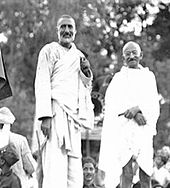 Khan Abdul Ghaffar Khan with Gandhi in 1930. Also known as Frontier Gandhi, Khan led the non-violent opposition against the British Raj and strongly opposed the partition of India.
Khan Abdul Ghaffar Khan with Gandhi in 1930. Also known as Frontier Gandhi, Khan led the non-violent opposition against the British Raj and strongly opposed the partition of India.
Until the 1930s, Muhammad Ali Jinnah was a member of the Indian National Congress and was part of the freedom struggle. Dr. Sir Allama Muhammad Iqbal, poet and philosopher, was a strong proponent of Hindu – Muslim unity and an undivdided India until the 1920s.Huseyn Shaheed Suhrawardy was also active in Indian National Congress in Bengal during his early political career. Maulana Muhammad Ali Jauhar and Maulana Shaukat Ali struggled for the emancipation of the Muslims in the overall Indian context, and struggled for freedom alongside Mahatama Gandhi and Maulana Abdul Bari of Firangi Mahal. Until the 1930s, the Muslims of India broadly conducted their politics alongside their countrymen, in the overall context of an undivided India.
Prominent Muslims in India
India is home to several eminent Muslims who have made their mark in several fields and have played a constructive role in India's economic rise and cultural influence across the world.
Out of the twelve Presidents of independent India, three were Muslims – Dr. Zakir Hussain, Dr Fakhruddin Ali Ahmed and Dr. A.P.J. Abdul Kalam. Additionally, Mohammad Hidayatullah, A. M. Ahmadi and Mirza Hameedullah Beg held the office of the Chief Justice of India on various occasions since independence. Mohammad Hidayatullah also served as the acting President of India on two separate occasions; and holds the distinct honor of being the only person to have served in all three offices of the President of India, the Vice President of India and the Chief Justice of India.[49][50]
The current Vice President of India, Mohammad Hamid Ansari, is a Muslim. Prominent Indian bureaucrats and diplomats include Abid Hussain and Asaf Ali. Zafar Saifullah was Cabinet Secretary of the Government of India from 1993 to 1994.[51] Salman Haidar was Indian Foreign Secretary from 1995 to 1997 and Deputy Permanent Representative of India to the United Nations.[52][53] Influential Muslim politicians in India include Sheikh Abdullah, Farooq Abdullah and his son Omar Abdullah (the current Chief Minister of Jammu and Kashmir), Mufti Mohammad Sayeed, Sikander Bakht, A R Antulay, C. H. Mohammed Koya, Mukhtar Abbas Naqvi, Salman Khurshid, Saifuddin Soz, E. Ahamed, Ghulam Nabi Azad, Syed Shahnawaz Hussain and Asaduddin Owaisi.[citation needed]
Some of the most popular and influential actors and actresses in Mumbai-based Bollywood are Muslims. These include Yusuf Khan (stage name Dilip Kumar),[54] Shahrukh Khan,[55] Aamir Khan,[56] Salman Khan,[57] Saif Ali Khan,[58][58][59] Madhubala,[60] Katrina Kaif and Emraan Hashmi.[61] India is also home to several critically acclaimed Muslim actors such as Naseeruddin Shah, Johnny Walker, Shabana Azmi,[62] Waheeda Rehman,[63]Amjad Khan, Parveen Babi, Feroz Khan, Meena Kumari, Prem Nazir, Mammootty, Nargis Dutt, Irrfan Khan, Farida Jalal, Arshad Warsi, Mehmood, Zeenat Aman, Farooq Sheikh and Tabu.
Some of the best known film-directors of Indian cinema include Mehboob Khan, K. A. Abbas, Kamal Amrohi, K. Asif and the Abbas-Mustan duo. Indian Muslims also play pivotal roles in other forms of performing arts in India, particularly in music, modern art and theater. M. F. Husain is one of India's best known contemporary artists. Academy Awards winners Resul Pookutty and A. R. Rahman, Naushad, Salim-Sulaiman and Nadeem Akhtar of the Nadeem-Shravan duo are some of India's most celebrated musicians. Abrar Alvi penned many of the greatest classics of Indian cinema. Prominent poets and lyricists include Javed Akhtar, Shakeel Badayuni, Sahir Ludhianvi and Majrooh Sultanpuri. Popular Indian singers of Muslim faith include Mohammed Rafi, Anu Malik, Lucky Ali, Talat Mahmood and Shamshad Begum. Another famous personality is the tabla maestro Zakir Hussian.
Sania Mirza, from Hyderabad, is the highest-ranked Indian woman tennis player. In cricket (the most popular game in India), there are many Muslim players who have made their mark. Iftikhar Ali Khan Pataudi, Mansoor Ali Khan Pataudi and Mohammad Azharuddin captained the Indian cricket team on various occasions. Other prominent Muslim cricketers in India are Mushtaq Ali, Syed Kirmani, Arshad Ayub, Mohammad Kaif,[Munaf Patel], Zaheer Khan, Irfan Pathan, Yusuf Pathan and Wasim Jaffer.
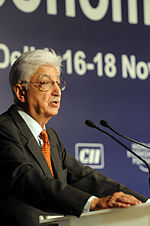 Azim Premji, CEO of India's 3rd largest IT company Wipro Technologies and the 5th richest man in India with an estimated fortune of US$17.1 billion.[64]
Azim Premji, CEO of India's 3rd largest IT company Wipro Technologies and the 5th richest man in India with an estimated fortune of US$17.1 billion.[64]
India is home to several influential Muslim businessmen. Some of India's most prominent firms, such as Wipro, Wockhardt, Himalaya Health Care, Hamdard Laboratories, Cipla and Mirza Tanners were founded by Muslims. The only two South Asian Muslim billionaires named by Forbes Magazine, Yusuf Hamied and Azim Premji, are from India.
Though Muslims are under-represented in the Indian Armed Forces compared to Hindus and Sikhs,[65] several Indian military Muslim personnel have earned gallantry awards and high ranks for exceptional service to the nation. Air Chief Marshal Idris Hasan Latif was Deputy Chief of the Air Staff during the Indo-Pakistani War of 1971 and later served as Chief of the Air Staff of the Indian Air Force from 1973 to 1976.[66][67] Indian Army's Abdul Hamid was posthumously awarded India's highest military decoration, the Param Vir Chakra, for knocking-out seven Pakistani tanks with a recoilless gun during the Battle of Asal Uttar in 1965.[68][69] Two other Muslims – Brigadier Mohammed Usman and Mohammed Ismail – were awarded Mahavir Chakra for their actions during the Indo-Pakistani War of 1947.[70] High ranking Muslims in the Indian Armed Forces include Lieutenant General Jameel Mahmood (former GOC-in-C Eastern Command of the Indian Army)[71] and Major General Mohammed Amin Naik.[72]
Dr. Abdul Kalam, one of India's most well respected scientists and the father of the Integrated Guided Missile Development Program (IGMDP) of India was honored through his appointment as the 11th President of India.[73] His extensive contribution to India's defense industry lead him to being nicknamed as the Missile Man of India[74] and during his tenure as the President of India, he was affectionately known as People's President. Dr. Syed Zahoor Qasim, former Director of the National Institute of Oceanography, led India's first scientific expedition to Antarctica and played a crucial role in the establishment of Dakshin Gangotri. He was also the former Vice Chancellor of Jamia Millia Islamia, Secretary of the Department of Ocean Development and the founder of Polar Research in India.[75] Other prominent Muslim scientists and engineers include C. M. Habibullah, a stem cell scientist and director of Deccan College of Medical Sciences and Allied Hospitals and Center for Liver Research and Diagnostics, Hyderabad;.[76] In the field of Unani medicine, one can name Hakim Ajmal Khan, Hakim Abdul Hameed and Hakim Syed Zillur Rahman.
Ahle Sunnat Sufi leader Hazrat Syed Muhammad Ameen Mian Qaudri and Sheikh Aboobacker Ahmad Musliyar have been included in the list of most influential Muslims list by Georgetown University. Maulana Mahmood Madani, leader of Jamiat Ulema-e-Hind and MP was ranked at 36 for initiating a movement against terrorism in South Asia.[77] Syed Ameen Mian has been ranked 44th in the list.
Indo-Islamic art and architecture
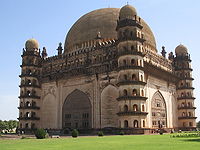 Gol Gumbaz at Bijapur, has the second largest pre-modern dome in the world after the Byzantine Hagia Sophia.
Gol Gumbaz at Bijapur, has the second largest pre-modern dome in the world after the Byzantine Hagia Sophia.
Indian architecture took new shape with the advent of Islamic rule in India towards the end of the 12th century AD. New elements were introduced into the Indian architecture that include: use of shapes (instead of natural forms); inscriptional art using decorative lettering or calligraphy; inlay decoration and use of coloured marble, painted plaster and brightly coloured glazed tiles. Quwwat-ul-Islam Mosque built in 1193 CE was the first mosque to be built in the Indian subcontinent; its adjoining "Tower of Victory", the Qutb Minar also started around 1192 CE, which marked the victory of Muhammad Ghori and his general Qutbuddin Aibak, from Ghazni, Afghanistan, over local Rajput kings, is now a UNESCO World Heritage Site in Delhi.
In contrast to the indigenous Indian architecture which was of the trabeate order i.e. all spaces were spanned by means of horizontal beams, the Islamic architecture was arcuate i.e. an arch or dome was adopted as a method of bridging a space. The concept of arch or dome was not invented by the Muslims but was, in fact, borrowed and further perfected by them from the architectural styles of the post-Roman period. Muslims used a cementing agent in the form of mortar for the first time in the construction of buildings in India. They further put to use certain scientific and mechanical formulae, which were derived by experience of other civilizations, in their constructions in India. Such use of scientific principles helped not only in obtaining greater strength and stability of the construction materials but also provided greater flexibility to the architects and builders. One fact that must be stressed here is that, the Islamic elements of architecture had already passed through different experimental phases in other countries like Egypt, Iran and Iraq before these were introduced in India. Unlike most Islamic monuments in these countries, which were largely constructed in brick, plaster and rubble, the Indo-Islamic monuments were typical mortar-masonry works formed of dressed stones. It must be emphasized that the development of the Indo-Islamic architecture was greatly facilitated by the knowledge and skill possessed by the Indian craftsmen, who had mastered the art of stonework for centuries and used their experience while constructing Islamic monuments in India.
Islamic architecture in India can be divided into two parts: religious and secular. Mosques and Tombs represent the religious architecture, while palaces and forts are examples of secular Islamic architecture. Forts were essentially functional, complete with a little township within and various fortifications to engage and repel the enemy.
Mosques: The mosque or masjid is a representation of Muslim art in its simplest form. The mosque is basically an open courtyard surrounded by a pillared verandah, crowned off with a dome. A mihrab indicates the direction of the qibla for prayer. Towards the right of the mihrab stands the mimbar or pulpit from where the Imam presides over the proceedings. An elevated platform, usually a minaret from where the Faithful are summoned to attend prayers is an invariable part of a mosque. Large mosques where the faithful assemble for the Friday prayers are called the Jama Masjids.
Tombs: Although not actually religious in nature, the tomb or maqbara introduced an entirely new architectural concept. While the masjid was mainly known for its simplicity, a tomb could range from being a simple affair (Aurangazeb’s grave) to an awesome structure enveloped in grandeur (Taj Mahal). The tomb usually consists of a solitary compartment or tomb chamber known as the huzrah in whose centre is the cenotaph or zarih. This entire structure is covered with an elaborate dome. In the underground chamber lies the mortuary or the maqbara, in which the corpse is buried in a grave or qabr. Smaller tombs may have a mihrab, although larger mausoleums have a separate mosque located at a distance from the main tomb. Normally the whole tomb complex or rauza is surrounded by an enclosure. The tomb of a Muslim saint is called a dargah. Almost all Islamic monuments were subjected to free use of verses from the Quran and a great amount of time was spent in carving out minute details on walls, ceilings, pillars and domes.
Islamic architecture in India can be classified into three sections: Delhi or the Imperial style (1191 to 1557AD); the Provincial style, encompassing the surrounding areas like Jaunpur and the Deccan; and the Mughal architecture style (1526 to 1707AD).[78]
Literature
- Elliot and Dowson: The History of India as told by its own Historians, New Delhi reprint, 1990.
- Elliot, Sir H. M., Edited by Dowson, John. The History of India, as Told by Its Own Historians. The Muhammadan Period; published by London Trubner Company 1867–1877. (Online Copy: The History of India, as Told by Its Own Historians. The Muhammadan Period; by Sir H. M. Elliot; Edited by John Dowson; London Trubner Company 1867–1877 – This online Copy has been posted by: The Packard Humanities Institute; Persian Texts in Translation; Also find other historical books: Author List and Title List)
- Majumdar, R. C. (ed.), The History and Culture of the Indian People, Volume VI, The Delhi Sultanate, Bombay, 1960; Volume VII, The Mughal Empire, Bombay, 1973.
- Mistry, Malika B. (December 2005). "Muslims in India: A demographic and socio-economic profile". Journal of Muslim Minority Affairs 25 (3): 399–422. doi:10.1080/13602000500408468.
- M K A Siddiqui (ed.), Marginal Muslim Communities In India, Institute of Objective Studies, New Delhi (2004) (review)
- Nizami, Khaliq Ahmad (1957). "Some Aspects of Khānqah Life in Medieval India". Studia Islamica (Maisonneuve &) 8 (8): 51–69. doi:10.2307/1595247. JSTOR 1595247.
Law and politics
Muslims in India are governed by "The Muslim Personal Law (Shariat) Application Act, 1937."[79] It directs the application of Muslim Personal Law to Muslims in marriage, mahr (dower), divorce, maintenance, gifts, waqf, wills and inheritance.[80] The courts generally apply the Hanafi Sunni law for Sunnis, Shia Muslims are independent of Sunni law for those areas where Shia law differs substantially from Sunni practice. However, in year 2005, Indian Shias broke away from the country's most important Muslim organization, the All India Muslim Personal Law Board and formed their sepearate Law Board as All India Shia Personal Law Board.[81]
The Indian constitution provides equal rights to all citizens irrespective of their religion. Article 44 of the constitution recommends a Uniform civil code. However, the attempts by successive political leadership in the country to integrate Indian society under common civil code is strongly resisted and is viewed by Indian Muslims as an attempt to dilute the cultural identity of the minority groups of the country. The All India Muslim Personal Law Board was established for the protection and continued applicability of “Muslim Personal Law” i.e. Shariat Application Act in India.
Further information: Haj subsidyConversion controversy
Considerable controversy exists both in scholarly and public opinion about the conversions to Islam typically represented by the following schools of thought:[82]
- The bulk of Muslims are descendants of migrants from the Iranian plateau or Arabs.[83]
- Conversions occurred for non-religious reasons of pragmatism and patronage such as social mobility among the Muslim ruling elite or for relief from taxes[82][83]
- Conversion was a result of the actions of Sunni Sufi saints and involved a genuine change of heart[82]
- Conversion came from Buddhists and the en masse conversions of lower castes for social liberation and as a rejection of the oppressive Hindu caste strictures.[83]
- A combination, initially made under duress followed by a genuine change of heart[82]
- As a socio-cultural process of diffusion and integration over an extended period of time into the sphere of the dominant Muslim civilization and global polity at large.[83]
Embedded within this lies the concept of Islam as a foreign imposition and Hinduism being a natural condition of the natives who resisted, resulting in the failure of the project to Islamicize the Indian subcontinent and is highly embroiled within the politics of the partition and communalism in India.[82] An estimate of the number of people killed, based on the Muslim chronicles and demographic calculations, was done by K.S. Lal in his book Growth of Muslim Population in Medieval India, who claimed that between 1000 CE and 1500 CE, the population of Hindus decreased by 80 million. His work has come under criticism by historians such as Simon Digby (School of Oriental and African Studies) and Irfan Habib for its agenda and lack of accurate data in pre-census times. Lal has responded to these criticisms in later works. Historians such as Will Durant contend that Islam was spread through violence.[84][85] Sir Jadunath Sarkar contends that several Muslim invaders were waging a systematic jihad against Hindus in India to the effect that "Every device short of massacre in cold blood was resorted to in order to convert heathen subjects."[86] Hindus who converted to Islam were not immune to persecution due to the Muslim Caste System in India established by Ziauddin al-Barani in the Fatawa-i Jahandari.,[87] where they were regarded as an "Ajlaf" caste and subjected to discrimination by the "Ashraf" castes[88]
Disputers of the "Conversion by the Sword Theory" point to the presence of the large Muslim communities found in Southern India, Sri Lanka, Western Burma, Bangladesh, Southern Thailand, Indonesia and Malaysia coupled with the distinctive lack of equivalent Muslim communities around the heartland of historical Muslim Empires in the Indian Sub-Continent as refutation to the "Conversion by the Sword Theory". The legacy of the Muslim conquest of South Asia is a hotly debated issue and argued even today. Different population estimates by economics historian Angus Maddison and by Jean-Noël Biraben also indicate that India's population did not decrease between 1000 and 1500, but increased by about 35 million during that time.[89][90]
Not all Muslim invaders were simply raiders. Later rulers fought on to win kingdoms and stayed to create new ruling dynasties. The practices of these new rulers and their subsequent heirs (some of whom were borne of Hindu wives) varied considerably. While some were uniformly hated, others developed a popular following. According to the memoirs of Ibn Batuta who travelled through Delhi in the 14th century, one of the previous sultans had been especially brutal and was deeply hated by Delhi's population, Batuta's memoirs also indicate that Muslims from the Arab world, Persia and Anatolia were often favored with important posts at the royal courts suggesting that locals may have played a somewhat subordinate role in the Delhi administration. The term "Turk" was commonly used to refer to their higher social status. S.A.A. Rizvi (The Wonder That Was India – II), however points to Muhammad bin Tughlaq as not only encouraging locals but promoting artisan groups such as cooks, barbers and gardeners to high administrative posts. In his reign, it is likely that conversions to Islam took place as a means of seeking greater social mobility and improved social standing.[91]
Religious conflict
Muslim-Hindu conflict
See also: Persecution of Muslims, Persecution of Hindus#During Islamic rule of the Indian sub-continent, and Religious violence in India- Before 1947
The conflict between Hindus and Muslims in the Indian subcontinent has a complex history which can be said to have begun with the Jihad of the Umayyad Caliphate in Sindh in 711. The persecution of Hindus during the Islamic expansion in India during the medieval period was characterized by destruction of temples, often illustrated by historians by the repeated destruction of the Hindu Temple at Somnath[92][93] and the anti-Hindu practices of the Mughal emperor Aurangzeb.[94]
- From 1947 to 1991
The aftermath of the Partition of India in 1947 saw large scale sectarian strife and bloodshed throughout the nation. Since then, India has witnessed sporadic large-scale violence sparked by underlying tensions between sections of the Hindu and Muslim communities. These conflicts stem in part from the ideologies of Hindu Nationalism and Islamic Extremism. Since independence, India has always maintained a constitutional commitment to secularism.
- Since 1992
The sense of communal harmony between Hindus and Muslims in the post-partition period was compromised greatly by the razing of the disputed Babri Mosque in Ayodhya. The demolition took place in 1992 and was allegedly perpetrated by the Hindu Nationalist Bharatiya Janata Party and organizations like Rashtriya Swayamsevak Sangh, Bajrang Dal and Vishwa Hindu Parishad. This was followed by tit for tat violence by Muslim and Hindu fundamentalists throughout the country, giving rise to the Bombay Riots and the 1993 Bombay Bombings. Amongst those allegedly involved in these atrocities were the Muslim Mafia don Dawood Ibrahim and the predominantly Muslim D-Company criminal gang.
In 2001 a high profile attack on the Indian Parliament by Islamic militants created considerable strain on community relations.
Some of the most violent events in recent times took place during the Gujarat riots in 2002, where it is estimated one thousand people were killed, most allegedly Muslim. Some sources claim there were approximately 2,000 Muslim deaths.[95] There were also allegations made of state involvement.[96][97] The riots were in retaliation to the Godhra Train Burning in which 50 Hindus pilgrims returning from the disputed site of the Babri Mosque, were burnt alive in a train fire at the Godhra railway station. Gujarat police claimed that the incident was a planned act carried out by extremist Muslims in the region against the Hindu pilgrims. The Bannerjee commission appointed to investigate this finding declared that the fire was an accident.[98] In 2006 the High Court decided the constitution of such a committee was illegal as another inquiry headed by Justice Nanavati Shah was still investigating the matter.[99]
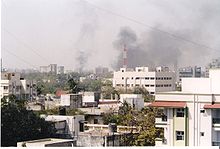 The skyline of Ahmedabad filled with smoke as buildings and shops are set on fire by rioting mobs. The riots, which took place following the Godhra train burning incident, killed more than 790 Muslims and 254 Hindus, including those killed in the Godhra train fire.[100]
The skyline of Ahmedabad filled with smoke as buildings and shops are set on fire by rioting mobs. The riots, which took place following the Godhra train burning incident, killed more than 790 Muslims and 254 Hindus, including those killed in the Godhra train fire.[100]
There was widespread communal violence in which Muslim communities suffered. In these riots, the role played by chief minister of Gujarat, Narendra Modi, and some of his ministers, police officers, and other right wing Hindu organization has been criticized. Narendra Modi was even accused of genocide.
Muslim-Hindu conflicts have also been fomented due to the mushrooming of Islamist organisations like SIMI (Students Islamic Movement of India) whose goal is to establish Islamic rule in India. Other Pakistan based groups such as the Lashkar-e-Toiba and Jaish-e-Mohammed have been fomenting bias in the local Muslim populace against Hindus. These groups are believed by many to be responsible for the 11 July 2006 Mumbai train bombings, in which nearly 200 people were killed. Such groups also attacked the Indian Parliament in 2001, declared parts of Indian Kashmir to be Pakistani in 1999 and have orchestrated numerous other attacks including constant attacks in Indian Kashmir and bombings in the Indian capital New Delhi. In the meantime, the toll of innocent Muslims and Hindus at the altar of communal strife continues to mount.[101]
As per Professor M.D. Nalapat (Vice-chairman of the Manipal Advanced Research Group, UNESCO Peace Chair, and professor of geopolitics at Manipal University), the reason for "Hindu – Muslim" conflict is "Hindu Backlash" or "partial" secularism, in which only Hindus are expected to be secular while Muslims and other minorities remain free to practice exclusionary practices.[102]
In 2004, several Indian school textbooks were scrapped by the National Council of Educational Research and Training after they were found to be loaded with anti-Muslim prejudice. The NCERT argued that the books were "written by scholars hand-picked by the previous Hindu nationalist administration". According to The Guardian, the textbooks depicted India's past Muslim rulers "as barbarous invaders and the medieval period as a dark age of Islamic colonial rule which snuffed out the glories of the Hindu empire that preceded it".[103] In one textbook, it was purported that the Taj Mahal, the Qutb Minar and the Red Fort—all examples of Islamic architecture—"were designed and commissioned by Hindus".[103]
In 2010 Deganga riots began on 6 September when an Islamist mob resorted to arson and violence on the Hindu localities of Deganga, Kartikpur and Beliaghata under the Deganga police station area. The violence began late in the evening and continued throughout the night into the next morning. The district police, Rapid Action Force, Central Reserve Police Force and Border Security Force all failed to stop the mob violence, army was finally deployed.[104][105][106][107] The army staged a flag march on the Taki Road, while Islamist violence continued unabated in the interior villages off the Taki Road, till Wednesday in spite of army presence and promulgation of prohibitory orders under section 144 of the CrPC.
Muslim-Sikh conflict
Sikhism emerged in the Punjab during the Mughal period. Conflict between early Sikhs and the Muslim power center at Delhi reached an early high point in 1606 when Guru Arjan Dev, the fifth guru of the Sikhs, was tortured and killed by Jahangir, the Mughal Emperor. After the death of the fifth beloved Guru his son had taken his spot Guru Har Gobind who basically made the Sikhs a warrior religion. Guru ji was the first to defeat the Mughal empire in a battle which had taken place in present Sri Hargobindpur in Gurdaspur[108] After this point the Sikhs were forced to organize themselves militarily for their protection. Later in the 16th century, Tegh Bahadur became guru in 1665 and led the Sikhs until 1675. Teg Bahadur was executed by the Mughal Emperor Aurangzeb for helping to protect Hindus, after a delegation of Kashmiri Pandits came to him for help when the Emperor condemned them to death for failing to convert to Islam.[109] This is an early example which illustrates how the Hindu-Muslim conflict and the Muslim-Sikh conflicts are connected.
In 1699, the Khalsa was founded by Guru Gobind Singh, the last guru. A former ascetic was charged by Gobind Singh with the duty of punishing those who had persecuted the Sikhs. After the guru's death, Baba Banda Singh Bahadur became the leader of the Sikh army and was responsible for several attacks on the Mughal empire. He was executed by the emperor Jahandar Shah after refusing the offer of a pardon if he converted to Islam.[110] The decline of Mughal power during the 17th and 18th centuries, along with the growing strength of the Sikh Confederacy and later, the Sikh Empire, resulted in a balance of power which protected the Sikhs from more violence. The Sikh Empire was absorbed into the British Indian empire after the Second Anglo-Sikh War of 1849.
Massive population exchanges took place during the Partition of India in 1947, and the British Indian province of Punjab was divided into two parts, and the western parts were given to the Dominion of Pakistan, while the eastern parts were given to the Union of India. 5.3 million Muslims moved from India to West Punjab in Pakistan, 3.4 million Hindus and Sikhs moved from Pakistan to East Punjab in India. The newly formed governments were completely unequipped to deal with migrations of such staggering magnitude, and massive violence and slaughter occurred on both sides of the border. Estimates of the number of deaths range around roughly 500,000, with low estimates at 200,000 and high estimates at 1,000,000.[111]
Muslim-Christian conflict
 The Jamalabad fort route. Mangalorean Catholics had traveled through this route on their way to Seringapatam
The Jamalabad fort route. Mangalorean Catholics had traveled through this route on their way to Seringapatam
In spite of the fact that there have been relatively fewer conflicts between Muslims and Christians in India in comparison to those between Muslims and Hindus, or Muslims and Sikhs, the relationship between Muslims and Christians have also been occasionally turbulent. With the advent of European colonialism in India throughout the 16th, 17th and 18th centuries, Christians were systematically persecuted in a few Muslim ruled kingdoms in India.
- Anti-Christian persecution by Tippu Sultan in the 17th century
Perhaps the most infamous acts of anti-Christian persecution by Muslims was committed by Tippu Sultan, the ruler of the Kingdom of Mysore against the Mangalorean Catholic community from Mangalore and the erstwhile South Canara district on the southwestern coast of India. Tippu was widely reputed to be anti-Christian. The captivity of Mangalorean Catholics at Seringapatam, which began on 24 February 1784 and ended on 4 May 1799, remains the most disconsolate memory in their history.[112]
The Bakur Manuscript reports him as having said: "All Musalmans should unite together, and considering the annihilation of infidels as a sacred duty, labor to the utmost of their power, to accomplish that subject."[113] Soon after the Treaty of Mangalore in 1784, Tippu gained control of Canara.[114] He issued orders to seize the Christians in Canara, confiscate their estates,[115] and deport them to Seringapatam, the capital of his empire, through the Jamalabad fort route.[116] However, there were no priests among the captives. Together with Fr Miranda, all the 21 arrested priests were issued orders of expulsion to Goa, fined Rs 2 lakhs, and threatened death by hanging if they ever returned.[113]
Tippu ordered the destruction of 27 Catholic churches, all beautifully carved with statues depicting various saints. Among them included the Church of Nossa Senhora de Rosario Milagres at Mangalore, Fr Miranda's Seminary at Monte Mariano, Church of Jesu Marie Jose at Omzoor, Chapel at Bolar, Church of Merces at Ullal, Imaculata Conceiciao at Mulki, San Jose at Perar, Nossa Senhora dos Remedios at Kirem, Sao Lawrence at Karkal, Rosario at Barkur, Immaculata Conceciao at Baidnur.[113] All were razed to the ground, with the exception of The Church of Holy Cross at Hospet,owing to the friendly offices of the Chauta Raja of Moodbidri.[117]
According to Thomas Munro, a Scottish soldier and the first collector of Canara, around 60,000 of them,[118] nearly 92 percent of the entire Mangalorean Catholic community, were captured, only 7,000 escaped. Francis Buchanan gives the numbers as 70,000 captured, from a population of 80,000, with 10,000 escaping. They were forced to climb nearly 4,000 feet (1,200 m) through the jungles of the Western Ghat mountain ranges. It was 210 miles (340 km) from Mangalore to Seringapatam, and the journey took six weeks. According to British Government records, 20,000 of them died on the march to Seringapatam. According to James Scurry, a British officer, who was held captive along with Mangalorean Catholics, 30,000 of them were forcibly converted to Islam. The young women and girls were forcibly made wives of the Muslims living there.[119] The young men who offered resistance were disfigured by cutting their noses, upper lips, and ears.[120] According to Mr. Silva of Gangolim, a survivor of the captivity, if a person who had escaped from Seringapatam was found, the punishment under the orders of Tippu was the cutting off of the ears, nose, the feet and one hand.[121]
The Archbishop of Goa wrote in 1800, "It is notoriously known in all Asia and all other parts of the globe of the oppression and sufferings experienced by the Christians in the Dominion of the King of Kanara, during the usurpation of that country by Tipu Sultan from an implacable hatred he had against them who professed Christianity."[113]
Tippu Sultan's invasion of the Malabar had an adverse impact on the Syrian Malabar Nasrani community of the Malabar coast. Many churches in the Malabar and Cochin were damaged. The old Syrian Nasrani seminary at Angamaly which had been the center of Catholic religious education for several centuries was razed to the ground by Tippu’s soldiers. A lot of centuries old religious manuscripts were lost forever. The church was later relocated to Kottayam where it still exists to this date. The Mor Sabor church at Akaparambu and the Martha Mariam Church attached to the seminary were destroyed as well. Tippu’s army set fire to the church at Palayoor and attacked the Ollur Church in 1790. Furthernmore, the Arthat church and the Ambazhakkad seminary was also destroyed. Over the course of this invasion, many Syrian Malabar Nasrani were killed or forcibly converted to Islam. Most of the coconut, arecanut, pepper and cashew plantations held by the Syrian Malabar farmers were also indiscriminately destroyed by the invading army. As a result, when Tippu's army invaded Guruvayur and adjacent areas, the Syrian Christian community fled Calicut and small towns like Arthat to new centres like Kunnamkulam, Chalakudi, Ennakadu, Cheppadu, Kannankode, Mavelikkara, etc. where there were already Christians. They were given refuge by Sakthan Tamburan, the ruler of Cochin and Karthika Thirunal, the ruler of Travancore, who gave them lands, plantations and encouraged their businesses. Colonel Macqulay, the British resident of Travancore also helped them.[122]
His persecution of Christians also extended to captured British soldiers. For instance, there were a significant amount of forced conversions of British captives between 1780 and 1784. Following their disastrous defeat at the battle of Pollilur, 7,000 British men along with an unknown number of women were held captive by Tipu in the fortress of Seringapatnam. Of these, over 300 were circumcised and given Muslim names and clothes and several British regimental drummer boys were made to wear ghagra cholis and entertain the court as nautch girls or dancing girls. After the 10 year long captivity ended, James Scurry, one of those prisoners, recounted that he had forgotten how to sit in a chair and use a knife and fork. His English was broken and stilted, having lost all his vernacular idiom. His skin had darkened to the swarthy complexion of negroes, and moreover, he had developed an aversion to wearing European clothes.[123] During the surrender of the Mangalore fort which was delievered in an armistice by the British and their subsequent withdrawal, all the Mestizos and remaining non-British foreigners were killed, together with 5,600 Mangalorean Catholics. Those condemned by Tipu Sultan for treachery were hanged instantly, the gibbets being weighed down by the number of bodies they carried. The Netravati River was so putrid with the stench of dying bodies, that the local residents were forced to leave their riverside homes.[113]
- Modern times
In modern times, Muslims in India who convert to Christianity are often subjected to harassment, intimidation, and attacks by Muslims. In Kashmir, the only Indian state with a Muslim majority, a Christian convert and missionary named Bashir Tantray was killed, allegedly by militant Islamists in 2006.[124]
Muslim-Buddhist conflict
In 1989 there was a social boycott by the Buddhists of the Muslims of Leh district. The boycott remained in force till 1992. Relations between the Buddhists and Muslims in Leh improved after the lifting of the boycott, although suspicions remained. In 2000's, the desacralization of the Quran in a village in Kargil and subsequent clashes between groups of Muslims and Buddhists in Leh and Kargil town are indicators of simmering tensions between the two major communities in Ladakh.[125]
Caste system among South Asian Muslims
Main article: Caste system among South Asian MuslimsCaste system among South Asian Muslims refers to units of social stratification that have developed among Muslims in South Asia.
Stratification
In some parts of South Asia, the Muslims are divided as Ashrafs and Ajlafs.[126] Ashrafs claim a superior status derived from their foreign ancestry.[30][127] The non-Ashrafs are assumed to be converts from Hinduism, and are therefore drawn from the indigenous population. They, in turn, are divided into a number of occupational castes.[127]
Sections of the ulema (scholars of Islamic jurisprudence) provide religious legitimacy to caste with the help of the concept of kafa'a. A classical example of scholarly declaration of the Muslim caste system is the Fatawa-i Jahandari, written by the fourteenth century Turkish scholar, Ziauddin Barani, a member of the court of Muhammad bin Tughlaq, of the Tughlaq dynasty of the Delhi Sultanate. Barani was known for his intensely casteist views, and regarded the Ashraf Muslims as racially superior to the Ajlaf Muslims. He divided the Muslims into grades and sub-grades. In his scheme, all high positions and privileges were to be a monopoly of the high born Turks, not the Indian Muslims. Even in his interpretation of the Koranic verse "Indeed, the pious amongst you are most honored by Allah", he considered piety to be associated with noble birth. Barrani was specific in his recommendation that the "sons of Mohamed" [i.e. Ashrafs] "be given a higher social status than the low-born [i.e. Ajlaf].[128] His most significant contribution in the fatwa was his analysis of the castes with respect to Islam.[128] His assertion was that castes would be mandated through state laws or "Zawabi" and would carry precedence over Sharia law whenever they were in conflict.[128] In the Fatwa-i-Jahandari (advice XXI), he wrote about the "qualities of the high-born" as being "virtuous" and the "low-born" being the "custodian of vices". Every act which is "contaminated with meanness and based on ignominity, comes elegantly [from the Ajlaf]".[128] Barani had a clear disdain for the Ajlaf and strongly recommended that they be denied education, lest they usurp the Ashraf masters. He sought appropriate religious sanction to that effect.[29] Barrani also developed an elaborate system of promotion and demotion of Imperial officers ("Wazirs") that was primarily on the basis of their caste.[128]
In addition to the Ashraf/Ajlaf divide, there is also the Arzal caste among Muslims, who were regarded by anti-Caste activists like Babasaheb Ambedkar as the equivalent of untouchables.[129][130] The term "Arzal" stands for "degraded" and the Arzal castes are further subdivided into Bhanar, Halalkhor, Hijra, Kasbi, Lalbegi, Maugta, Mehtar etc.[129][130][131] The Arzal group was recorded in the 1901 census of India and are also called Dalit Muslims “with whom no other Muhammadan would associate, and who are forbidden to enter the mosque or to use the public burial ground”.They are relegated to "menial" professions such as scavenging and carrying night soil.[132]
Some South Asian Muslims have been known to stratify their society according to Quoms.[133] These Muslims practise a ritual-based system of social stratification. The Quoms who deal with human emissions are ranked the lowest. Studies of Bengali Muslims in India indicate that the concepts of purity and impurity exist among them and are applicable in inter-group relationships, as the notions of hygiene and cleanliness in a person are related to the person's social position and not to his/her economic status.[127] Muslim Rajput is another caste distinction among Indian Muslims.
Some of the backward or lower-caste Muslim communities include Ansari, Kunjra, Churihara, Dhobi and Halalkhor. The upper and middle caste Muslim communities include Syed, Shaikh, Shaikhzada, Khanzada, Pathan, Mughal, and Malik .[134] Genetic data has also supported this stratification.[135] It should be noted that most of the claims for Arabic ancestry in India is flawed and points to Arabic preferences in local Shariah. Interestingly, in three genetic studies representing the whole of South Asian Muslims, it was found that the Muslim population was overwhelmingly similar to the local non-Muslims associated with minor but still detectable levels of gene flow from outside, primarily from Iran and Central Asia, rather than directly from the Arabian Peninsula.[12]
The Sachar Committee's report commissioned by the government of India and released in 2006, documents the continued stratification in Muslim society.
Interaction and Mobility
Interactions between the oonchi zat (upper caste) and neechi zat (lower caste) are regulated by established patron-client relationships of the jajmani system, the upper castes being referred to as the 'Jajmans', and the lower caste as 'Kamin'. Upon contact with a low-caste Muslim, a Muslim of a higher zat can "purify" by taking a short bath, since there are no elaborate rituals for purification.[127] In Bihar state of India, cases have been reported in which the higher caste Muslims have opposed the burials of lower caste Muslims in the same graveyard.[134]
Some data indicates that the castes among Muslims have never been as rigid as that among Hindus.[136][136] An old saying also goes in Bangladesh "Last year I was a Julaha (weaver); this year a Shaikh; and next year if the harvest be good, I shall be a Sayyid.".[137] However, other scholars, such as Ambedkar, disagreed with this thesis.(see criticism below). The well-known Sufi, Sayyed Jalaluddin Bukhari, also known as Makhdum Jahaniyan-e-Jahangasht, is said to have declared that providing knowledge beyond that of the Quran and the rules of prayers and fasting to the so-called razil (ajlafs) castes is like scattering pearls before swine and dogs! He reportedly insisted that other Muslims should not eat with barbers, washers of corpses, dyers, tanners, cobblers, bow-makers and washermen, besides consumers of alcohol and usurers. Mohammad Ashraf writes in his “Hindustani Maashra Ahd-e-Usta Main” that many medieval Islamic rulers did not allow to low-class people to enter their courts, or if some did they forbade them from opening their mouths because they considered them to be ‘impure’.[32] The scholar Shabbir Ahmad Hakeem quotes from another book by Thanvi called “Masawat-e Bahar-e Shariat”, in which Thanvi argues that Muslims should not allow ‘Julahas’ (weavers) and ‘Nais’ (barbers) to enter Muslims’ homes. In his “Bahishti Zewar” Thanvi claimed that the son of a Sayyed father and a non-Sayyed mother is socially inferior to the child of a Sayyed couple.
In his “Imdad ul-Fatawa”, Thanvi announced that Sayyeds, Shaikhs, Mughals and Pathans are all ‘respectable’ (sharif) communities, and that the oil-presser (Teli) and weaver (Julaha) communities are ‘low’ castes (razil aqwam). He claimed that ‘nau-Muslims’, non-Arab converts to Islam, cannot be considered the kafaa, for purposes of marriage, of ‘established Muslims’ (khandani musalman). Accordingly, he argued, Pathans, being non-Arabs and, therefore, ‘nau-Muslims’, are not the kafaa of Sayyeds and Shaikhs, who claim Arab descent, and, so, cannot inter-marry with them. The first president of All India Muslim Personal Law Board and Vice Chancellor of the Deoband madrasa, Maulvi Qari Mohammad Tayyeb Siddiqui, was also supporter of casteism and wrote two books in support in Mufti Usmani’s book on caste: “Ansab wa Qabail Ka Tafazul” and “Nasb Aur Islam”. True to this tradition of legitimising caste, even today the admission form of the Deoband madrasa has a column that asks for applicants to mention their caste. For many years after it was established, non-ashraf students were not generally admitted in the Deoband and the practice still continues.
Criticism
Some Muslim scholars have termed the caste-like features in Indian Muslim society as a "flagrant violation of the Qur'anic worldview.". However, most Muslim scholars tried to reconcile and resolve the "disjunction between Qur'anic egalitarianism and Indian Muslim social practice" through theorizing it in different ways and interpreting the Quran and Sharia to justify casteism.[138]
While some scholars theorize that the Muslim Castes are not as acute in their discrimination as that among Hindus,[29][136] Dr B.R.Ambedkar argued otherwise, writing that the social evils in Muslim society were "worse than those seen in Hindu society".[129][130]
Babasaheb Ambedkar was an illustrious figure in Indian politics and the chief architect of the Indian Constitution. He was extremely critical of the Muslim Caste System and their practices, quoting that "Within these groups there are castes with social precedence of exactly the same nature as one finds among the Hindus but worse in numerous ways". He was critical of how the Ashrafs regarded the Ajlaf and Arzal as "worthless" and the fact that Muslims tried to sugarcoat the sectarian divisions by using euphemisms like "brotherhood" to describe them. He was also critical of the precept of literalism of scripture among Indian Muslims that led them to keep the Muslim Caste system rigid and discriminatory. He decried against the approval of Shariah to Muslim casteism. It was based on superiority of foreign elements in society which would ultimately lead to downfall of local Dalits. This tragedy would be much more harsher than Hindus who are ethnically related to and supportive of Dalits. This Arabian supermacy in Indian Muslims accounted for its equal disapproval by high and low caste Hindus during 1300 years of Islamic presence in India. He condemned the Indian Muslim Community of being unable to reform like Muslims in other countries like Turkey did during the early decades of the twentieth century.[129][130]
Pakistani-American sociologist Ayesha Jalal writes, in her book, "Democracy and Authoritarianism in South Asia",that "Despite its egalitarian principles, Islam in South Asia historically has been unable to avoid the impact of class and caste inequalities. As for Hinduism, the hierarchical principles of the Brahmanical social order have always been contested from within Hindu society, suggesting that equality has been and continues to be both valued and practiced in Hinduism ."[139]
See also: Caste system among South Asian MuslimsMuslim institutes
There are several well established Muslim institutes in India. Here is a list of reputed institutes established by Muslims in India.
- Modern Universities and institutes:
- Aligarh Muslim University
- Anjuman-I-Islam, Mumbai.
- Era's Lucknow Medical College, Lucknow
- Jamal Mohamed College, Trichirapally
- Dar-us Salam Education Trust, Hyderabad
- Jamia Millia Islamia
- Hamdard University, Delhi
- Al-Barkaat Educational Institutions, Aligarh
- The Maulana Azad Education Society, Aurangabad
- Dr. Rafiq Zakariya Campus, Aurangabad
- Al Ameen Educational Society
- Crescent Engineering College
- Al-Kabir educational society
- Darul Uloom Deoband Saharanpur
- Darul-uloom Nadwatul Ulama
- Integral University
- Ibn Sina Academy of Medieval Medicine and Sciences
- National College Of Engineering,Tirunelveli
- Al Falah School of Engineering and Technology,Faridabad
- Darul Huda Islamic University
- Osmania University, Hyderabad
- Shadan Medical College, Hyderabad
- Deccan Medical College, Hyderabad
- Muslim Educational Association of Southern India
- Aliah University
- M.S.S.Wakf Board College, Madurai (The only college in India run by a State Wakf Board)
- Traditional Islamic Universities:
- Darul Uloom Hyderabad, Hyderabad
- Jamia Nizamia, Hyderabad
- Markazu Saqafathi Sunniya,Kerala
- Jamia Darul Huda Islamiyya
- Raza Academy
Muslim population by states
Muslim population in Indian states according to 2001 Census.[140]
State Population Percentage Lakshadweep Islands 56,353 93 Jammu & Kashmir 6,793,240 66.9700 Assam 8,240,611 30.9152 West Bengal 20,240,543 25.2451 Kerala 7,863,842 24.6969 Uttar Pradesh 30,740,158 18.4961 Bihar 13,722,048 16.5329 Jharkhand 3,731,308 13.8474 Karnataka 6,463,127 12.2291 Uttaranchal 1,012,141 11.9225 Delhi 1,623,520 11.7217 Maharashtra 10,270,485 10.6014 Andhra Pradesh 6,986,856 9.1679 Gujarat 4,592,854 9.0641 Manipur 190,939 8.8121 Rajasthan 4,788,227 8.4737 Andaman & Nicobar Islands 29,265 8.2170 Tripura 254,442 7.9533 Daman & Diu 12,281 7.7628 Goa 92,210 6.8422 Madhya Pradesh 3,841,449 6.3655 Pondicherry 59,358 6.0921 Haryana 1,222,916 5.7836 Tamil Nadu 3,470,647 5.5614 Meghalaya 99,169 4.2767 Chandigarh 35,548 3.9470 Dadra & Nagar Haveli 6,524 2.9589 Orissa 761,985 2.0703 Chhattisgarh 409,615 1.9661 Himachal Pradesh 119,512 1.9663 Arunachal Pradesh 20,675 1.8830 Nagaland 35,005 1.7590 Punjab 80,045 1.5684 Sikkim 7,693 1.4224 Mizoram 10,099 1.1365 Percentage distribution of population (adjusted) by religious communities : India – 1961 to 2001 Census (excluding Assam and J&K).[3]
Year Percentage 1951 10.1% 1971 10.4% 1981 11.9% 1991 12.0% 2001 12.8% Percentage distribution (unadjusted) of population by religious communities India – 1961 to 2001 Census (without excluding Assam and J&K).[3]
Year Percentage 1961 10.7% 1971 11.2% 1981 12.0% 1991 12.8% 2001 13.4% Table : Census information for 2001: Hindu and Muslim compared[α][β] Composition Hindus[141] Muslims[142] % total of population 2001 80.5 13.4 10-Yr Growth % (est '91–'01)[16][β] 20.3 36.0 Sex ratio* (avg. 933) 931 936 Literacy rate (avg. 64.8) 65.1 59.1 Work Participation Rate 40.4 31.3 Rural sex ratio[16] 944 953 Urban sex ratio[16] 894 907 Child sex ratio (0–6 yrs) 925 950 Islamic traditions in South Asia
Sufism is a mystical dimension of Islam, often complimentary with the legalistic path of the sharia had a profound impact on the growth of Islam in India. A Sufi attains a direct vision of oneness with God, often on the edges of orthodox behavior, and can thus become a Pir (living saint) who may take on disciples (murids) and set up a spiritual lineage that can last for generations. Orders of Sufis became important in India during the thirteenth century following the ministry of Moinuddin Chishti (1142–1236), who settled in Ajmer, Rajasthan, and attracted large numbers of converts to Islam because of his holiness. His Chishtiyya order went on to become the most influential Sufi lineage in India, although other orders from Central Asia and Southwest Asia also reached India and played a major role in the spread of Islam. In this way, they created a large literature in regional languages that embedded Islamic culture deeply into older South Asian traditions.
Leadership and Organizations
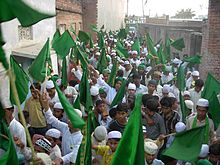 Milad Procession in India.
Milad Procession in India.
- The All India Muslim Personal Law Board, a body of Muslim religious leaders Indian government recognises as representative of Indian Muslims.[48]
- In mid 2005–2006 an estimated 2/3-rds of the 15 crore Indian Muslim population are believed to be adherents of the Sunni Barelwi school of thought and follow Sufi traditions like Mawlid,Dargah visit, Dhikr and mysticism.[143] Manzar-e-Islam Bareilly and Al Jamiatul Ashrafia are most famous Seminary of Barelwi Muslims.Raza Academy
- Indian Shiite Muslims form a substantial minority within the Muslim community of India comprising between 25%–31% of total Muslim population in an estimation done during mid 2005–2006 of the then Indian Muslim population of 157 million. Sources like Times of India and DNA reported Indian Shiite population during that period between 40,000,000[144][144] to 50,000,000[145] of 157,000,000 Indian Muslim population[146][147]
- The Deobandis, another influential section of the Muslim population following the Hanafi school of thought of India originate from the Darul Uloom Deoband (house/abode of knowledge), an influential religious seminary in the district of Saharanpur of Uttar Pradesh. The seminary is known for its nationalist orientation and played an important role in the Indian freedom struggle.The Jamiat-ul-Ulema-e-Hind, founded by Deobandi scholars in 1919, supported the Indian National Congress in the national freedom movement and became a political mouthpiece for the Daru'l Uloom.[148]
- The Tablighi Jamaat (Outreach Society) became active after the 1940s as a movement, primarily among the ulema (religious leaders), stressing personal renewal, prayer, a missionary spirit and attention to orthodoxy. It has been highly critical of the kind of activities that occur in and around Sufi shrines and remains a minor if respected force in the training of the ulema. Conversely, other ulema have upheld the legitimacy of mass religion, including exaltation of pirs and the memory of the Prophet. A powerful secularising drive led by Syed Ahmad Khan resulted in the foundation of Aligarh Muslim University (1875 as the Muhammadan Anglo-Oriental College)-with a broader, more modern curriculum, and other major Muslim universities.
- The Jamaat-e-Islami Hind (Islamic Party), founded in 1941, advocates the establishment of an Islamic government and has been active in promoting education, social service and ecumenical outreach to the community.[149]
Haj subsidy
Main article: Haj subsidyThe government of India subsidizes the cost of the airfare for Hajj pilgrims. Subsidized pilgrims must pay a portion of the ticket cost, with the balance paid by the Indian government. Previously, all pilgrims travelled on Air India, but from 2011 pilgrims fly on planes operated by Hellinic International Airways.[150] In compliance to Allahabad High Court directions, the Government of India has proposed that starting from 2011, the amount of government subsidy per person will be decreased, and by 2017 will be ended completely.[151]
Ghettoisation of Indian Muslims
Though walled cities, have been traditional dwellings of Muslims in older cities, many upper class Muslims moved out post-Partition and started living in other parts of the cities. Ghettoisation amongst Indian Muslims began in the mid-1970s when first communal riots occurred, this heightened after the Bhagalpur riots 1989, and became a trend after the Babri Masjid demolition in 1992, soon several major cities developed ghettos, or segregated areas where the Muslim population moved in.[152] The trend however, did not help in the anticipated security that the anonymity of ghetto was thought to have provided, as seen during 2002 Gujarat riots, where several such ghettos became easy targets, as it only aided in profiling of residential colonies.[153][154][155][156]
Increase in ghetto living has also shown a strengthening of social stereotyping due to lack of cross-cultural interaction, and reduction in economic and educational opportunities at large. On the other hand, the larger community which for centuries had benefited from its interactions with Islamic traditions, to create a rich cultural and social fabric, formed through amalgamation of the two diverse traditions faces a danger of fast becoming insular.[157] Secularism in India is being seen by some as a favour to the minorities, and not as a imperative for democracy.[158][159]
See also
- Bihari Muslim
- Hyderabadi Muslim
- Tamil Muslim
- Hinduism and Islam
- Indian Muslim nationalism
- Hindu nationalism
- List of Indian Muslims
- NCERT controversy
References
- ^ Mapping the Global Muslim Population Pew Forum.
- ^ CIA's The World Factbook – India
- ^ a b c Census of Indian: Religious Composition
- ^ Sharma, Usha. Cultural and Religious Heritage of India: Islam. Mittal Publications, 2004. ISBN 817099960X, 9788170999607.
- ^ E. Dunn, Ross. The adventures of Ibn Battuta, a Muslim traveler of the fourteenth century. University of California Press, 1986. ISBN 0520057716, 9780520057715.
- ^ Tharoor, Shashi. India: From Midnight to the Millennium and Beyond. Arcade Publishing, 2006. ISBN 1559708034, 9781559708036.
- ^ Muslim Personal Law (Shariat) Application Act, 1937 – Resources for Jurisdictional Research, Yale
- ^ The Hatreds of India; Hindu Memory Scarred by Centuries Of Sometimes Despotic Islamic Rule New York Times, Published: 11 December 1992
- ^ Pg 11, Indian and foreign review By India. Ministry of Information and Broadcasting. Publications Division
- ^ Muslims of India
- ^ Journal of Human Genetics (2009-05-08). "Access : Diverse genetic origin of Indian Muslims: evidence from autosomal STR loci : Journal of Human Genetics". Nature.com. http://www.nature.com/jhg/journal/v54/n6/full/jhg200938a.html. Retrieved 14 September 2010.
- ^ a b c The mostly South Asian origins of Indian Muslims
- ^ Kashif-ul-Huda (2007-05-06). "Access : Genetically Indian: Story of Indian Muslims". Radiance Viewsweekly. http://www.radianceweekly.com/57/407/draught-of-character-in-the-high-ups/2007-05-06/science-amp-technology/story-detail/genetically-indianstory--of-indian-muslims.html. Retrieved 2011-03-18.
- ^ a b Guilmoto, Christophe. Fertility transition in south India. SAGE, 2005. ISBN 0761932925, 9780761932925.
- ^ India’s Muslim Population by Carin Zissis for Council of Foreign Relations
- ^ a b c d "Census of India.". Census of India. Census Data 2001: India at a glance >> Religious Composition. Office of the Registrar General and Census Commissioner, India. http://www.censusindia.gov.in/Census_Data_2001/India_at_glance/religion.aspx. Retrieved 2008-11-26.
- ^ Changes in Fertility Rates Among Muslims in India, Pakistan, and Bangladesh by Eric Zuehlke for Population Reference Bureau
- ^ Jeffery, Roger and Patricia Jeffery. Population, gender, and politics. Cambridge University Press, 1997. ISBN 0521466539, 9780521466530.
- ^ Prasad, B.K.. Population and family life education. Anmol Publications PVT. LTD., 2004. ISBN 8126118008, 9788126118007.
- ^ Shakeel Ahmad. Muslim attitude towards family planning. Sarup & Sons, 2003. ISBN 8176253898, 9788176253895.
- ^ Nair, V. Balakrishnan. Social development and demographic changes in South India: focus on Kerala. M.D. Publications Pvt. Ltd., 1994. ISBN 8185880506, 9788185880501.
- ^ Paul Kurtz. Multi-Secularism: A New Agenda. Transaction Publishers, 2010. ISBN 1412814197, 9781412814195.
- ^ a b c Narain Singh, Surya. Muslims in India. Anmol Publications PVT. LTD., 2003. ISBN 8126114274, 9788126114276.
- ^ Muslim population could decline: Sachar report, Rediff News
- ^ India as an Ostrich, by Swapan Dasgupta, Rediff News
- ^ Longman, Phillip (November 2010). "Think Again: Global Aging". Foreign Policy. http://www.foreignpolicy.com/articles/2010/10/11/think_again_global_aging?page=0,2. Retrieved 26 November 2010.
- ^ Burton-Page, J. "Hindū." Encyclopaedia of Islam. Edited by: P. Bearman, Th. Bianquis, C.E. Bosworth, E. van Donzeland W.P. Heinrichs. Brill, 2006. Brill Online.
- ^ Muslim Caste in Uttar Pradesh (A Study of Culture Contact), Ghaus Ansari, Lucknow, 1960, Page 66
- ^ a b c Singh Sikand, Yoginder. "Caste in Indian Muslim Society". Hamdard University. http://stateless.freehosting.net/Caste%20in%20Indian%20Muslim%20Society.htm. Retrieved 2006-10-18.
- ^ a b Aggarwal, Patrap (1978). Caste and Social Stratification Among Muslims in India. Manohar.
- ^ Bhatty, Zarina (1996). "Social Stratification Among Muslims in India". In M N Srinivas. Caste: Its Twentieth Century Avatar. Viking, Penguin Books India. pp. 249–253. ISBN 0140257608. http://www.anti-caste.org/muslim_question/caste/bhatty_article.html. Retrieved 2007-06-12.
- ^ a b "Pasmanda Muslim Forum: Caste and Social Hierarchy Among Indian Muslims: M.A.Falahi (Interview)". Dalitmuslims.com. 2008-08-10. http://www.dalitmuslims.com/2008/08/caste-and-social-hierarchy-among-indian.html. Retrieved 14 September 2010.
- ^ People of India: Maharashtra – Google Books. Books.google.co.in. 2004. ISBN 9788179911013. http://books.google.com/?id=BsBEgVa804IC&pg=PA942&lpg=PA942&dq=kasai+caste#v=onepage&q=kasai%20caste&f=false. Retrieved 14 September 2010.
- ^ Jami Masjid
- ^ ISBN 81-86050-79-5 Ancient and Medieval History of India
- ^ ISBN 983-9154-80-X
- ^ Sturrock, J.,South Canara and Madras District Manual (2 vols., Madras, 1894–1895)
- ^ ISBN 81-85843-05-8 Cultural Heritage of India Vol. IV
- ^ a b -Genesis and Growth of the Mappila Community
- ^ William Logan, Malabar Manual, Asian Educational Services, 1996 ISBN 8120604466, 9788120604469
- ^ -Cheraman Juma Masjid A Secular Heritage
- ^ Bahrain tribune World’s second oldest mosque is in India
- ^ -A mosque from a Hindu king
- ^ Saliba, George (2007). Islamic Science and the Making of the European Renaissance. The MIT Press. ISBN 978-0-262-19557-7.
- ^ The Ismaili, their history and doctrine by Farhad Daftary. Chapter -Mustalian Ismailism-p.300-310
- ^ "Number of Ahmadis in India". Immigration and Refugee Board of Canada. 1 November 1991. http://www.unhcr.org/refworld/topic,464db4f52,47f237db2,3ae6ad202c,0.html. Retrieved 9 March 2009.
- ^ a b Hoque, Ridwanul (21 March 2004). "On right to freedom of religion and the plight of Ahmadiyas". The Daily Star. http://www.thedailystar.net/law/2004/03/03/index.htm.
- ^ a b Naqvi, Jawed (1 September 2008). "Religious violence hastens India’s leap into deeper obscurantism". Dawn. http://www.dawn.com/weekly/jawed/20080109.htm. Retrieved 23 December 2009.
- ^ "M. Hidayatullah". Supreme Court of India. http://www.supremecourtofindia.nic.in/judges/bio/mhidayatullah.htm. Retrieved 2008-06-08.
- ^ "EBC article on J. Hidayatullah". EBC (India). http://www.ebc-india.com/lawyer/articles/92v4a2.htm. Retrieved 2008-06-08.
- ^ Pg 252, Independent India: the first fifty years, Hiranmay Karlekar, Indian Council for Cultural Relations,Oxford University Press, 1998
- ^ http://apcd.anu.edu.au/transforum/2004/participants.html
- ^ BBC News. http://news.bbc.co.uk/nol/shared/spl/hi/programmes/analysis/transcripts/15_03_07.txt.
- ^ Tanuja Chandra (3 March 2004) Dilip Kumar: Silent Revolutionary Sify Movies. Retrieved on 2009-03-30.
- ^ Zubair Ahmed (23 September 2005) Who's the real Shah Rukh Khan? BBC News (BBC). Retrieved on 2009-03-30.
- ^ Aamir speaks out on alienation as a Muslim IndiaGlitz (5 August 2005). Retrieved on 2009-03-30.
- ^ Salman Khan NNDB. Retrieved on 2009-03-30.
- ^ a b Deepa Gahlot (July 1998) ‘Religion played a major role in my upbringing’ Sabrang Communications. Retrieved on 2009-04-03.
- ^ Subhash K Jha (21 August 2008) ‘I went to a Muslim builder,' says Saif The Times of India. Retrieved on 2009-03-30.
- ^ Madhubala Top News. Retrieved on 2009-03-30.
- ^ Arya Aiyappan (20 November 2006) Parveen Shahani to wed Emraan Hashmi One India. Retrieved on 2009-03-30.
- ^ Indian democracy unfair to Muslims: Shabana Azmi The Times of India. 17 August 2008. Retrieved on 2009-04-03.
- ^ Waheeda Rehman Bollywood501. Retrieved on 2009-03-04.
- ^ Frugal billionaires
- ^ Arvind Kala: Hiding what`s well-known
- ^ Air Chief Marshal Idris Hasan Latif, PVSM
- ^ Pg 118, Civil-military relations: regional perspectives, Morris Janowitz, Inter-university Seminar on Armed Forces and Society, Sage Publications, 1981
- ^ [Maj Gen Cardozo, Ian (2003). PARAM VIR. New Delhi: Lotus Collection. ISBN 81-7436-262-2]
- ^ The Param Vir Chakra Winners' home page for Company Quarter Master Havildar Abdul Hamid
- ^ MAHA VIR CHAKRA, Bharat-Rakshak
- ^ Anil Bhat Posted: 14 Feb 2006 at 0000 hrs IST (2006-02-14). "Brave Indians, also Muslim". The Indian Express. India. http://www.indianexpress.com/oldStory/87825/. Retrieved 14 September 2010.
- ^ CJ: Rajesh Bhat. "A high-profile 'Naik' of Indian Army". Merinews.com. http://www.merinews.com/article/a-high-profile-naik-of-indian-army/132377.shtml. Retrieved 14 September 2010.
- ^ Abdul Kalam
- ^ R. K. Pruthi.President A.P.J. Abdul Kalam. Anmol Publications, 2002. ISBN 978-81-261-1344-6; Ch. 4. Missile Man of Idia. pp. 61–76
- ^ Interview: Dr SZ Qasim
- ^ Hope hangs on stem cell therapy
- ^ Bhaskar Roy, TNN, 12 Dec 2009, 12.54 am IST (2009-12-12). "Kalam, Shah Rukh in most influential Muslims list – The Times of India". Timesofindia.indiatimes.com. http://timesofindia.indiatimes.com/india/Kalam-Shah-Rukh-in-most-influential-Muslims-list/articleshow/5328554.cms. Retrieved 14 September 2010.
- ^ (Courtesy: Culturopedia.com)
- ^ The Muslim Personal Law (Shariat) Application Act, 1937 Vakilno1.com
- ^ India, Republic of Emory School of Law
- ^ Mukerjee, Sutapa (9 February 2005). "India's Muslims face up to rifts". BBC NEWS. http://news.bbc.co.uk/2/hi/south_asia/4235999.stm. Retrieved 2010-06-23.
- ^ a b c d e der Veer, pg 27–29
- ^ a b c d Eaton, Richard M. The Rise of Islam and the Bengal Frontier, 1204–1760. Berkeley: University of California Press, c1993 1993.Online version last accessed on 1 May 2007
- ^ Durant, Will. "The Story of Civilization: Our Oriental Heritage" (page 459).
- ^ Elst, Koenraad (2006-08-25). "Was there an Islamic "Genocide" of Hindus?". Kashmir Herald. http://www.kashmirherald.com/main.php?t=OP&st=D&no=138. Retrieved 2006-08-25.
- ^ Sarkar, Jadunath. How the Muslims forcibly converted the Hindus of India, Pakistan and Bangladesh to Islam.
- ^ Caste in Indian Muslim Society
- ^ Aggarwal, Patrap (1978). Caste and Social Stratification Among Muslims in India. Manohar.
- ^ Maddison, Angus (2006). The Contours of the World Economy 1–2030 AD. Oxford University Press.
- ^ Biraben, Jean-Noël (2003). "The rising numbers of humankind", Populations & Societies 394.
- ^ Islam and the sub-continent – appraising its impact
- ^ "Somnath Temple". http://www.indhistory.com/somnath-temple.html. Retrieved 2009-04-17.
- ^ "Somanatha and Mahmud". http://www.flonnet.com/fl1608/16081210.htm. Retrieved 2008-04-17.
- ^ Richards, John F. (1995). The Mughal Empire. Cambridge: Cambridge University Press. pp. 130, 177. ISBN 0-521-56603-7.
- ^ India's Great Divide. Retrieved on 4 April 2007.
- ^ India's Great Divide. Retrieved on 4 April 2007.
- ^ Demand for CBI probe into Zaheera's u-turn.The Hindu. Retrieved on 4 April 2007.
- ^ Still a burning question
- ^ "Banerjee panel illegal: Gujarat HC". The Indian Express. 2006-10-13. http://www.expressindia.com/fullstory.php?newsid=75485. Retrieved 14 September 2010.
- ^ These figures were reported to the Rajya Sabha by the Union Minister of State for Home Affairs Sriprakash Jaiswal in May, 2005. "Gujarat riot death toll revealed". BBC News. 2005-05-11. http://news.bbc.co.uk/2/hi/south_asia/4536199.stm. PTI (2005-05-12). "BJP cites govt statistics to defend Modi". ExpressIndia. http://www.expressindia.com/fullstory.php?newsid=46626. PTI (2005-05-11). "254 Hindus, 790 Muslims killed in post-Godhra riots". Indiainfo.com. http://news.indiainfo.com/2005/05/11/1105godhra-rs.html.
- ^ "Islamist Militancy in Kashmir: The Case of the Lashkar-i Tayyeba by Yoginder Sikand | November 20, 2003". Sacw.net. http://www.sacw.net/DC/CommunalismCollection/ArticlesArchive/sikand20Nov2003.html. Retrieved 14 September 2010.
- ^ A Hindu backlash hits Sonia Gandhi – upiasiaonline.com
- ^ a b Ramesh, Randeep. Another rewrite for India's history books, The Guardian.
- ^ "Communal clash near Bangla border, Army deployed". The Times of India (Kolkata). 8 September 2010. http://timesofindia.indiatimes.com/india/Communal-clash-near-Bangla-border-Army-deployed/articleshow/6516123.cms. Retrieved 11 September 2010.
- ^ "Army out after Deganga rioting". The Times of India (Kolkata). 8 September 2010. http://timesofindia.indiatimes.com/city/kolkata-/Army-out-after-Deganga-rioting/articleshow/6516493.cms. Retrieved 11 September 2010.
- ^ "Curfew in Bengal district, Army called in". The Indian Express (Kolkata). 8 September 2010. http://www.indianexpress.com/news/Curfew-in-Bengal-district--Army-called-in/678774. Retrieved 11 September 2010.
- ^ Bose, Raktima (8 September 2010). "Youth killed in group clash". The Hindu (Chennai, India). http://www.hindu.com/2010/09/08/stories/2010090859680100.htm. Retrieved 11 September 2010.
- ^ Shackle, Christopher; Mandair, Arvind-Pal Singh (2005). Teachings of the Sikh Gurus: Selections from the Sikh Scriptures. United Kingdom: Routledge. pp. xv–xvi. ISBN 0-415-26604-1.
- ^ Rama, Swami (1986). Celestial Song/Gobind Geet: The Dramatic Dialogue Between Guru Gobind Singh and Banda Singh Bahadur. Himalayan Institute Press. pp. 7–8. ISBN 0-89389-103-7.
- ^ Singh, Khushwant (2006). The Illustrated History of the Sikhs. India: Oxford University Press. pp. 47–53. ISBN 0-19-567747-1.
- ^ Death toll in the partition
- ^ "Deportation & The Konkani Christian Captivity at Srirangapatna (1784 Feb. 24th Ash Wednesday)". Daijiworld Media Pvt Ltd Mangalore. http://www.daijiworld.com/chan/achievers_view.asp?a_id=28. Retrieved 2008-02-29.
- ^ a b c d e Sarasvati's Children, Joe Lobo
- ^ Forrest 1887, pp. 314–316]
- ^ The Gentleman's Magazine 1833, p. 388
- ^ "Christianity in Mangalore". Diocese of Mangalore. Archived from the original on 2008-06-22. http://web.archive.org/web/20080622155343/http://www.dioceseofmangalore.org/history.asp. Retrieved 2008-07-30.
- ^ John B. Monteiro. "Monti Fest Originated at Farangipet – 240 Years Ago!". Daijiworld Media Pvt Ltd Mangalore. http://www.daijiworld.com/chan/exclusive_arch.asp?ex_id=129. Retrieved 2009-04-28.
- ^ Bowring 1997, p. 126
- ^ Scurry & Whiteway 1824, p. 103
- ^ Scurry & Whiteway 1824, p. 104
- ^ Account of a Surviving Captive, A Mr. Silva of Gangolim (Letter of a Mr. L.R. Silva to his sister, a copy of which was given by an advocate, M.M. Shanbhag, to the author, Severino da Silva, and reproduced as Appendix No. 74: History of Christianity in Canara (1965))
- ^ K.L. Bernard, Kerala History , pp. 79
- ^ William Dalrymple White Mughals (2006) p28
- ^ Christian convert from Islam shot dead in Kashmir,SperoNews
- ^ http://www.countercurrents.org/comm-sikand130206.htm
- ^ Asghar Ali Engineer. "On reservation for Muslims". The Milli Gazette. Pharos Media & Publishing Pvt Ltd,. http://www.milligazette.com/Archives/2004/01-15Sep04-Print-Edition/011509200449.htm. Retrieved 2004-09-01.
- ^ a b c d e Das, Arbind, Arthashastra of Kautilya and Fatwa-i-Jahandari of Ziauddin Barrani: an analysis, Pratibha Publications, Delhi 1996, ISBN 81-85268-45-2 pgs 124–143
- ^ a b c d Ambedkar, Bhimrao. Pakistan or the Partition of India. Thackers Publishers.
- ^ a b c d Web resource for Pakistan or the Partition of India
- ^ Gitte Dyrhagen and Mazharul Islam (2006-10-18). "Consultative Meeting on the situation of Dalits in Bangladesh". International Dalit Solidarity Network. Archived from the original on 2007-08-03. http://web.archive.org/web/20070803023637/http://www.idsn.org/Documents/asia/pdf/Bangladesh_full_report.pdf. Retrieved 2007-06-12.
- ^ Dereserve these myths by Tanweer Fazal,Indian express
- ^ Barth, Fredrik (1962). "The System Of Social Stratification In Swat, North Pakistan". In E. R. Leach. Aspects of Caste in South India, Ceylon, and North-West Pakistan. Cambridge University Press. p. 113. http://www.questia.com/PM.qst?a=o&d=2995517. Retrieved 2007-06-12.
- ^ a b Anand Mohan Sahay. "Backward Muslims protest denial of burial". Rediff.com. http://www.rediff.com/news/2003/mar/06bihar.htm. Retrieved 2003-03-06.
- ^ Gene Diversity in Some Muslim Populations of North India Human Biology – Volume 77, Number 3, June 2005, pp. 343–353 – Wayne State University Press
- ^ a b c Madan, T.N. (1976). Muslim communities of South Asia : culture and society. Vkas Publishing House. p. 114. ISBN 978-0706904628.
- ^ Ikram, S. M. (1964). "The Interaction of Islam and Hinduism". Muslim Civilization in India. New York: Columbia University Press. http://www.columbia.edu/itc/mealac/pritchett/00islamlinks/ikram/part1_09.html. Retrieved 2007-06-12.
- ^ Yoginder Singh Sikand, Caste in Indian Muslim Society
- ^ A. Jalal,Democracy and Authoritarianism in South Asia: A Comparative and Historical Perspective (Contemporary South Asia), Cambridge University Press (26 May 1995), ISBN 0-521-47862-6
- ^ Indian Census 2001 – Religion
- ^ "Tables: Profiles by main religions: Hindus" (PDF). Census of India 2001: DATA ON RELIGION. Office of the Registrar General, India. http://www.censusindia.gov.in/. Retrieved 2007-04-17.
- ^ "Tables: Profiles by main religions: Muslims" (PDF). Census of India 2001: DATA ON RELIGION. Office of the Registrar General, India. http://www.censusindia.gov.in/. Retrieved 2007-04-17.
- ^ Sandeep Unnithan and Uday Mahurkar (2008-07-31). "The radical sweep: Cover Story : India Today". Indiatoday.digitaltoday.in. http://indiatoday.digitaltoday.in/index.php?option=com_content&task=view&id=12343&Itemid=1&issueid=67&limit=1&limitstart=0. Retrieved 14 September 2010.
- ^ a b "Shia women too can initiate divorce". The Times of India (India). 6 November 2006. http://timesofindia.indiatimes.com/city/lucknow/Shia-women-too-can-initiate-divorce/articleshow/334804.cms. Retrieved 2010-06-21.
- ^ "Talaq rights proposed for Shia women". Daily News and Analysis, www.dnaindia.com. 5 November 2006. http://www.dnaindia.com/india/report_talaq-rights-proposed-for-shia-women_1062327. Retrieved 2010-06-21.
- ^ "India Third in Global Muslim Population". Twocircles.net. http://twocircles.net/2009oct08/india_third_global_muslim_population_1_57_bn.html. Retrieved 2010-07-03.
- ^ International Religious Freedom Report 2003. By the United States Department of State. Retrieved on 19 April 2007.
- ^ The Fatwa against Terrorism: Indian Deobandis Renounce Violence but Policing Remains Unchanged, Kamala Kanta Dash, (Monash Asia Institute, Monash University, Australia), 2008 GTReC International Conference
- ^ Pg 32, INTRODUCTION, A Historical Overview of Islam in South Asia, Islam in South Asia in Practice- by Barbara D. Metcalf Princeton University Press,2009
- ^ George, Daniel P (17 June 2011). "Haj may cost less; new airline to carry pilgrims". The Times of India. http://articles.timesofindia.indiatimes.com/2011-06-17/chennai/29669335_1_haj-pilgrims-flight-tickets-and-accommodation-airline. Retrieved 14 July 2011.
- ^ Ranjan, Amitav (13 October 2010). "Haj subsidy cuts start soon". The India Express. http://www.indianexpress.com/news/haj-subsidy-cuts-start-soon/696844/. Retrieved 14 July 2011.
- ^ SUBVERSE| Pariahs in our own home The Times of India, 23 April 2009.
- ^ Ghettoisation Of A City & The Nation
- ^ Post Gujrat Riots Crisis and contention in Indian society, by T. K. Oommen. Published by SAGE, 2005. ISBN 0-7619-3359-X. Page 119
- ^ Human Development and Social Power: Perspectives from South Asia, by Ananya Mukherjee Reed. Published by Taylor & Francis, 2008. ISBN 0-415-77552-3. Page 149.
- ^ India's Muslims feel backlash by Jill McGivering, BBC Delhi correspondent. BBC News, Thursday, 6 June 2002.
- ^ Ghettoisation of Muslims in India: Trends and Consequences By Imran Ali and Yoginder Sikand. The Milli Gazette Online, 12 February 2006.
- ^ Ghettoisation The Hindu, 1 August 2006.
- ^ The price of exclusion Ranjit Hoskote, The Hindu, 31 December 2006.
Studies
- Asghar Ali Engineer, Islam in India: The Impact of Civilizations. Shipra Publications, 2002. ISBN 81-7541-115-5.
- Mohamed Taher. Muslims in India: Recent Contributions to Literature on Religion, Philosophy, History, & Social Aspects. Anmol Publications PVT. LTD., 1993. ISBN 81-7041-620-5. Excerpts
- Mohammad Mujeeb. The Indian Muslims. McGill University Press, 1967. ISBN 0-7735-0021-9.
- Murray Thurston Titus, Indian Islam: A Religious History of Islam in India. Milford, Oxford university press, 1930. ISBN 81-7069-096-X
- Yogindar Sikand. Muslims in India Since 1947: Islamic Perspectives on Inter-faith Relations. Routledge, 2004. ISBN 0-415-31486-0.
 This article incorporates public domain material from websites or documents of the Library of Congress Country Studies.
This article incorporates public domain material from websites or documents of the Library of Congress Country Studies.
External links
Articles
- Indian Muslims are descendants of locals, says scientific study
- Overview of Islamism in India – by Husain Haqqani, Hudson Institute
- Indian Muslims Inc, Their Market & Global Business Impact, Special Report by DinarStandard.com
- The Missing Muslim, the Sunday Express. Full coverage on Sachar Report
- Frontline Magazine, pay. Hindu.com
- India Muslims have lowest rank, BBC
- Why India's 150m Muslims are missing out on the country's rise, Economist
- Muslim India struggles to escape the past, Guardian Unlimited
- India's Muslim Population, Council on Foreign Relations
- India's Great Divide, Time
- Sisodia, Rajeshree India: End of Hindu-Muslim Mistrust? IslamOnline.net
- Online Copy: The History of India, as Told by Its Own Historians. The Muhammadan Period; by Sir H. M. Elliot; Edited by John Dowson; London Trubner Company 1867–1877 – This online Copy has been posted by: The Packard Humanities Institute; Persian Texts in Translation; Also find other historical books: Author List and Title List
Islam in Asia Sovereign
statesAfghanistan · Armenia · Azerbaijan · Bahrain · Bangladesh · Bhutan · Brunei · Burma (Myanmar) · Cambodia · People's Republic of China · Cyprus · East Timor (Timor-Leste) · Egypt · Georgia · India · Indonesia · Iran · Iraq · Israel · Japan · Jordan · Kazakhstan · North Korea · South Korea · Kuwait · Kyrgyzstan · Laos · Lebanon · Malaysia · Maldives · Mongolia · Nepal · Oman · Pakistan · Philippines · Qatar · Russia · Saudi Arabia · Singapore · Sri Lanka · Syria · Tajikistan · Thailand · Turkey · Turkmenistan · United Arab Emirates · Uzbekistan · Vietnam · Yemen
States with limited
recognitionAbkhazia · Nagorno-Karabakh · Northern Cyprus · Palestine · Republic of China (Taiwan) · South Ossetia
Dependencies and
other territoriesChristmas Island · Cocos (Keeling) Islands · Hong Kong · Macau
Indian Muslim communities Majority Arain · Arghon · Ansari · Baghban · Balti · Behna · Bhatiara · Bhishti · Bisati · Burig · Chaush · Dard · Dhobi · Ghosi · Gujjar · Hyderabadi · Iraqi · Khanzada · Kashmiri · Kunjra · Labbay · Malkana · Manihar · Meo · Mughal · Nawayath · Pathans · Qassab · Ranghar · Rangrez · Saifi · Shaikh · Sayyid · Salmani · Siddi · Teli
Minority Bihar Gujarat Abdal · Alavi Bohra · Ansari · Arabs · Attarwala · Bafan · Baloch · Banjara · Behlim · Bhadala · Bharbhunja · Bhishti · Chhipa · Chunara · Chundrigar · Dawoodi Bohra · Dhobi · Dhuldhoya · Doodwala · Faqir · Galiara · Ghanchi · Ghanchi-Pinjara · Halaypotra · Hingorja · Hingora · Jats of Kutch · Juneja · Kadia · Kagzi · Ker · Khaskheli · Khoja · Machiyar · Makrani · Malik of Gujarat · Mandali · Makwana · Manka · Mansoori · Memon · Meta Qureshi · Miyana · Molesalam · Momna · Mughal · Multani · Multani Lohar · Mutwa · Nagori · Nayak · Node · Panar · Parmar · Patani Bohra · Patni Jamat · Pathans of Gujarat · Salaat · Samma · Sandhai Muslims · Sanghar · Shaikhs of Gujarat · Shaikhda · Sayyid of Gujarat · Siddi · Sipahi · Soomra · Sulaymani Bohra · Sunni Bohra · Surti Muslims · Tai · Turk Jamat · Vora Patel · Vyapari · Wagher
Karnataka Baghban · Beary · Chaush · Chhaparband · Kodagu Mappila · Konkani Muslims · Nawayath · Siddi
Kerala Maharashtra Attar · Baghban · Bhishti · Chaush · Chhaparband · Dhawad · Faqir · Garodi · Gavandi · Kachar · Kagzi · Konkani Muslims · Momin · Muslim Raj Gond · Qassab · Saiqalgar · Tadvi Bhil
Punjab Dakoha Sadaat
Rajasthan Tamil Nadu Uttar Pradesh Ahbans Khanzada · Ansari · Atishbaz · Bachgoti Khanzada · Baghban · Baluch · Bandhmati · Banjara · Barhai · Behlim · Bannu Israil · Behna · Bhand · Bharbhunja · Bhale Sultan Khanzada · Bhatti Khanzada · Bhatiara · Bhishti · Bhumihar Musalman · Bisen Khanzada · Bisati · Chandel Khanzada · Chik · Dafali · Dhagi · Dharhi · Dhobi Musalmaan · Dogar · Fareedi · Faqir · Gaddi · Garha · Gautam Khanzada · Ghosi · Goriya · Gujjar Musalmaan · Halalkhor · Halwai · Idrisi · Iraqi · Jat Musalmaan · Jhojha · Kabaria · Kakorvi Shaikh · Kamangar · Kamboh · Kasgar · Kayastha Musalman · Khanzada · Khokhar Khanzada · Khumra · Kingharia · Kunjra · Lal Begi · Lalkhani Rajput · Madari · Mandarkia · Malkana · Manihar · Meo · Milki · Mirasi · Mughal · Mujavir · Muker · Nagar Muslims · Nalband · Nanbai · Naqqal · Panchpiria · Pankhiya · Pathans of Uttar Pradesh · Putliwale · Qalandar · Qassab · Qaum-e-Punjaban · Qidwai · Rai Bhatt · Raj · Rajput Musalmaan · Ramaiya · Rangrez · Rayeen · Rohilla · Sadaat Amroha · Saadat-e-Bara · Sadaat-e-Bilgram · Sai · Saifi · Salmani · Sayyid of Uttar Pradesh · Shaikh of Uttar Pradesh · Shaikh Ja'fri · Shaikhzada · Siddiqui · Sikarwar Khanzada · Teli Musalmaan · Turk · Tyagi Musalmaan · Zamindara
West Bengal Categories:
Wikimedia Foundation. 2010.

